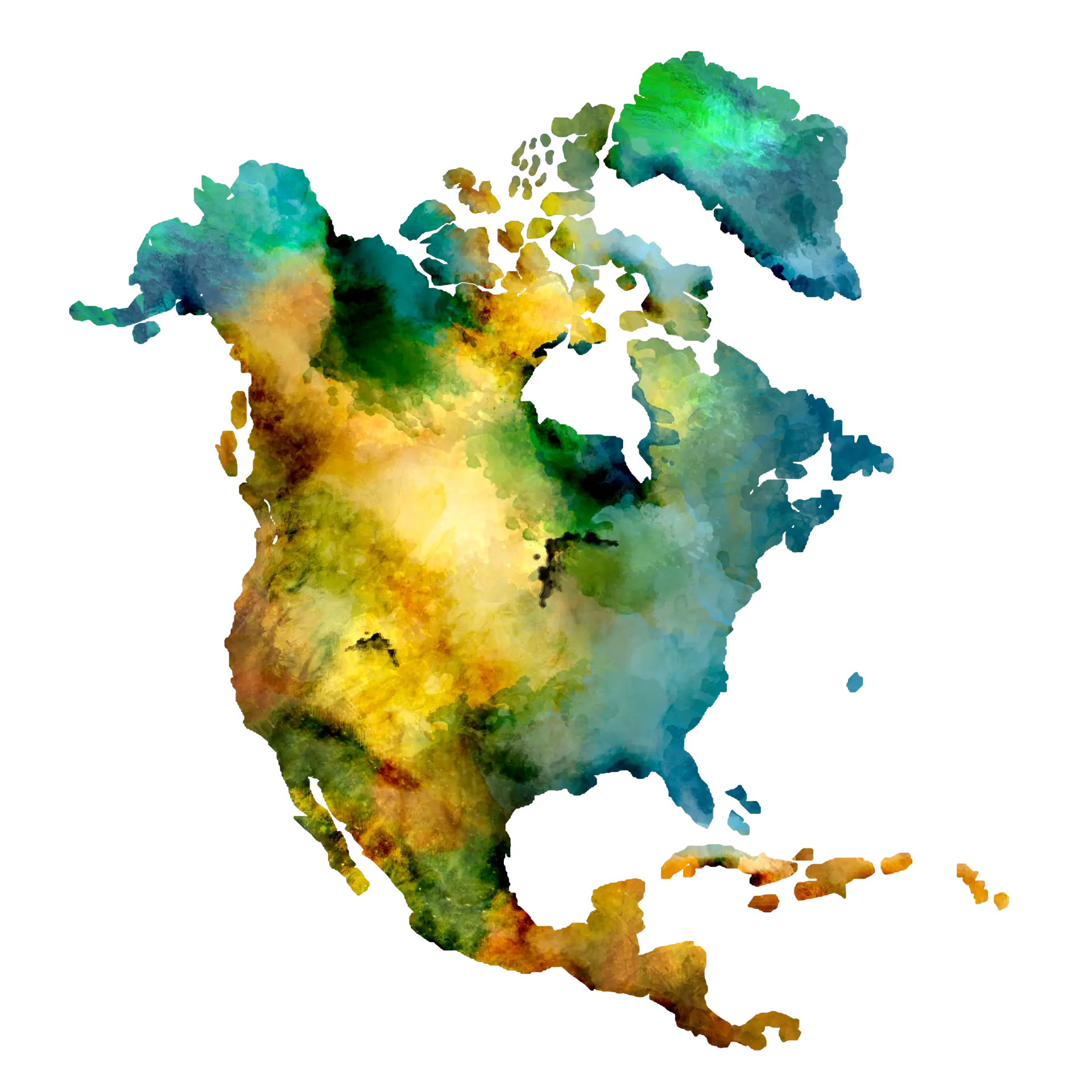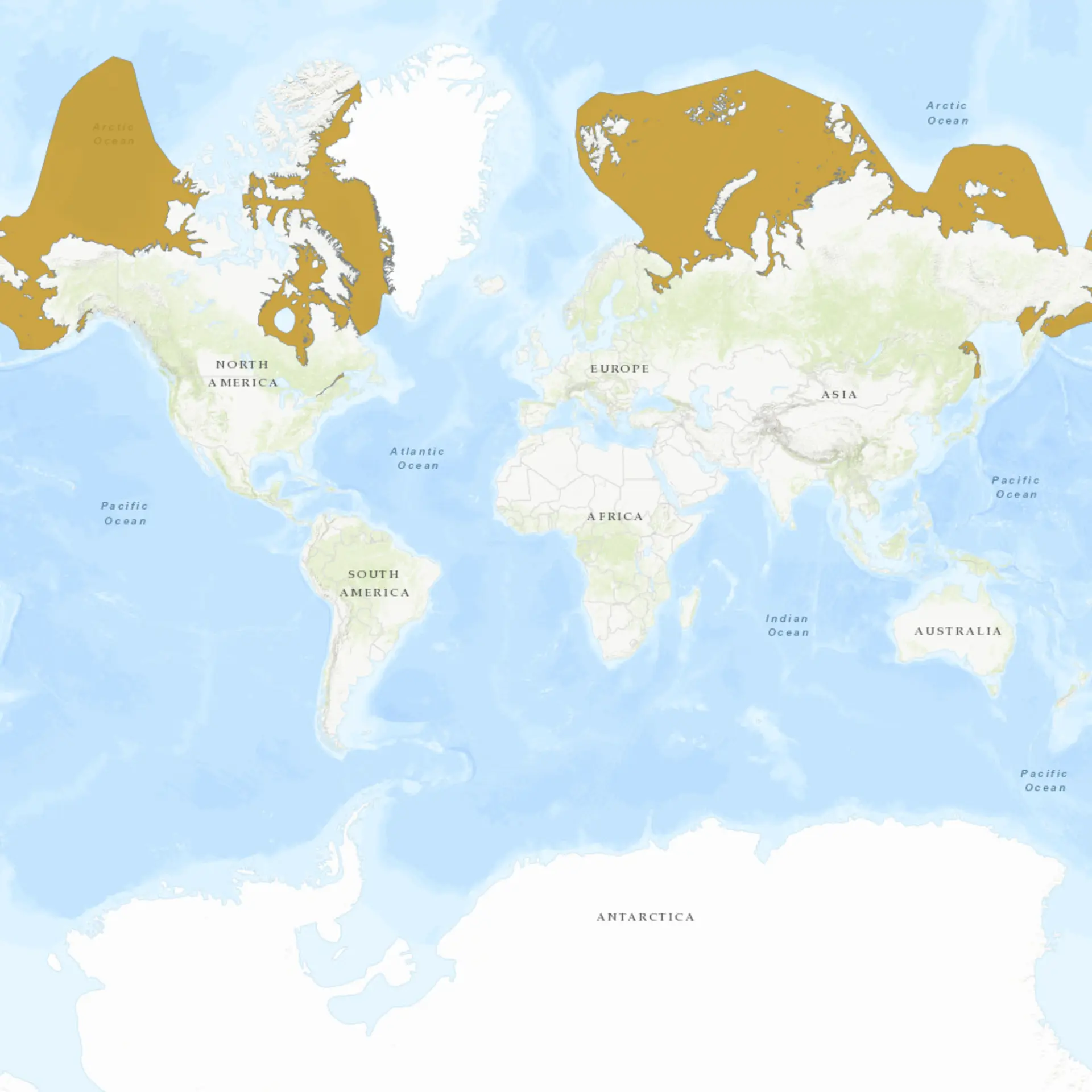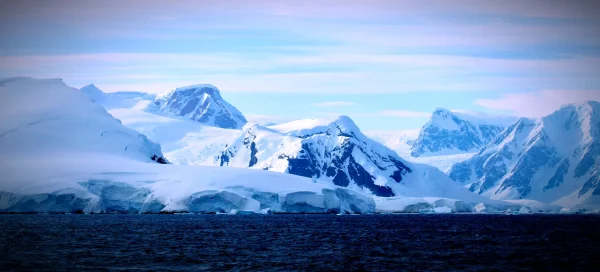Overview
The Beluga Whale (Delphinapterus leucas), the white whale, is a small-to-medium-sized toothed whale found in Arctic and sub-Arctic waters. Recognized for its striking white coloration, rounded head, and lack of a dorsal fin, the beluga is one of the most distinctive marine mammals. It is highly social, living in pods and communicating with an extensive range of vocalizations, earning it the nickname “sea canary.” Belugas play an essential role in Arctic ecosystems as predators of fish and invertebrates and as prey for apex predators like polar bears and orcas.
This species is highly adapted to life in icy waters, with a thick layer of blubber for insulation and the ability to navigate under sea ice. Belugas are migratory, often traveling between Arctic summer feeding grounds, coastal estuaries, or sub-Arctic regions in winter. Their flexible necks allow them to turn their heads in all directions, aiding in foraging and social interactions. Despite their adaptability, belugas face threats from climate change, industrial activity, and pollution, especially in regions where human activity intersects with their habitat.
The IUCN classifies belugas as Least Concern globally, and their population is stable at about 150,000. However, some regional populations, such as those in Cook Inlet and the St. Lawrence River, are critically endangered due to habitat degradation and human-induced threats. To ensure the survival of this iconic Arctic species, conservation efforts focus on habitat protection, hunting regulation, and mitigating the impacts of industrial development.
Taxonomy
Kingdom
Phylum
Class
Order
Family
Genus
Species
Type
Current distribution:
Belugas are distributed throughout Arctic and sub-Arctic regions, with populations in Canada, Alaska, Greenland, Russia, and Norway. In North America, key populations include those in the Beaufort and Chukchi Seas, Hudson Bay, and the St. Lawrence River. While most populations are migratory, some, like the Cook Inlet and St. Lawrence River belugas, are year-round residents. Seasonal migrations bring them to estuaries and coastal areas during summer, while wintering habitats are typically under or near sea ice.
Globally, the beluga population is estimated at around 150,000 individuals. However, some populations, such as Cook Inlet and St. Lawrence River belugas, are critically endangered due to habitat degradation and human-induced threats. International conservation efforts focus on protecting key habitats and mitigating the impacts of climate change and industrial activity on their ecosystems.
Physical Description:
The Beluga Whale is easily recognizable by its all-white coloration, which helps it blend into its icy habitat. It has a small, rounded dorsal fin and broad, paddle-like flippers. The absence of a dorsal fin allows it to swim easily under ice. Its most distinctive feature is the melon, a fatty structure on its forehead used for echolocation.
Both male and female Belugas appear similarly, although males are generally larger and have a more pronounced melon. The skin of the Beluga is thick and rubbery, providing insulation against the cold waters of the Arctic and sub-Arctic regions. Its eyes are small, and it has a well-developed sense of hearing, essential for communication and navigation.

Lifespan: Wild: ~50 Years || Captivity: ~60 Years

Weight: Male: 2,400–3,500 lbs (1,100–1,600 kg) || Female: 1,100–2,000 lbs (500–900 kg)

Length: Male: 13–16 ft (4–4.9 m) || Female: 11–13 ft (3.4–4 m)

Top Speed: 14 mph (22 km/h)
Characteristic:
Native Habitat:
Beluga whales inhabit cold Arctic and sub-Arctic waters, including coastal areas, estuaries, and deeper offshore regions. They are often associated with sea ice, which protects from predators like orcas and access to prey-rich waters. During the summer, belugas migrate to warmer estuaries and river mouths, such as the Mackenzie River Delta in Canada and Cook Inlet in Alaska, where they molt their skin and feed intensively. These shallow, sheltered habitats also serve as critical areas for calving and nursing.
In winter, belugas move to areas with broken sea ice or ice-free waters, often traveling along leads (openings in the ice) to reach feeding grounds. They are highly adaptable and can dive to depths of up to 2,000 feet (600 meters) to forage, though they generally prefer shallower waters. Human activity, such as shipping and industrial development, has increasingly encroached on their habitats, highlighting the importance of protected areas for their conservation.
Climate Zones:
Biomes:
WWF Biomes:
Biogeographical Realms:
Continents:
Countries:
Diet:
Diet & Feeding Habits:
Beluga whales are opportunistic feeders. Their diet primarily consists of fish, such as Arctic cod, capelin, salmon, squid, shrimp, and other crustaceans. They use their echolocation abilities to locate prey in murky or dark waters, often foraging along the seafloor or in the water column. Belugas lack fused teeth for chewing and instead use their peg-like teeth to grasp and swallow prey whole. Seasonal migrations to prey-rich estuaries and coastal areas allow them to exploit the abundance of food during summer.
Cooperative foraging is common, with belugas often working together to herd schools of fish into dense clusters for easier capture. They may also stir up sediment on the seafloor to uncover hidden prey. Their diet varies depending on location and season, with some populations relying more heavily on crustaceans and mollusks. In captivity, belugas are fed a controlled fish diet supplemented with vitamins to meet their nutritional needs.
Mating Behavior:
Mating Description:
Beluga whales are polygynous, with males competing for access to females during the breeding season between late winter and early spring. Courtship behaviors include physical displays, vocalizations, and tactile interactions, such as rubbing against each other. After mating, females carry their calves for a gestation period of 14–15 months, typically giving birth to a single calf in summer, when warmer, shallow waters provide safety and food abundance.
Newborn calves are approximately 4–5 feet (1.2–1.5 meters) long and weigh around 120–150 pounds (55–68 kg). They nurse on their mother’s rich milk for up to two years, although they begin eating solid food within the first year. Mothers provide extensive care, often forming nursery pods with other females to protect and nurture their young. Belugas reach sexual maturity at 4–7 years for females and 7–9 years for males, with females generally breeding every three years.
Reproduction Season:
Birth Type:
Pregnancy Duration:
Female Name:
Male Name:
Baby Name:
Social Structure Description:
Beluga Whales are highly social animals that live in groups called pods. These pods can range in size from a few individuals to several dozen. They have complex social hierarchies and often form alliances, particularly for hunting and mating. Communication is a key aspect of their social structure, and they use a variety of vocalizations, body language, and even touch to interact.
Within a pod, there are often smaller sub-groups based on age, sex, or family relationships. These sub-groups may change frequently, reflecting the dynamic nature of their social interactions. They are known for their playful behavior, often engaging in activities like leaping, surfing on waves, and playing with objects or other marine animals.
Groups:
Conservation Status:
Population Trend:
While some populations of Beluga Whales are stable, others are critically endangered due to threats such as pollution, climate change, and human activities. Conservation efforts are focused on protecting critical habitats and reducing these threats. Various laws and international agreements aim to protect the species, although challenges remain in enforcing these measures.
Public awareness campaigns and research are ongoing to better understand their complex social structures, behaviors, and needs. This research aims to inform conservation strategies and promote responsible interaction with these animals, particularly in areas where they are popular tourist attractions.
Population Threats:
The primary threats to Beluga Whales are pollution, climate change, and human activities such as shipping and fishing. Chemical pollutants can accumulate in their tissues, leading to health issues. Noise pollution from boat traffic and industrial activities can interfere with their echolocation and communication.
Climate change poses an additional threat, as it could lead to changes in sea ice and the distribution of prey species, affecting their ability to find food. Increased human activities in the Arctic, such as shipping and oil drilling, pose risks through potential oil spills and collisions.
Conservation Efforts:
Conservation efforts for the Beluga Whale include legal protections, habitat conservation, and public awareness campaigns. Various international agreements aim to protect the species from hunting and capture. Efforts are also being made to reduce pollution and the risk of collisions with ships.
Educational programs aim to inform the public about the importance of conserving this species and promoting responsible interaction, particularly in areas where they are popular tourist attractions. Ongoing research is focused on understanding their complex social structures, behaviors, and needs, which will aid in future conservation efforts.
Additional Resources:
Fun Facts
- Belugas are among the most vocal whale species, earning them the nickname “sea canaries.”
- Unlike most whales, belugas can turn their heads in all directions due to their unfused cervical vertebrae.
- They lack a dorsal fin, which helps them conserve heat and navigate under sea ice.
- Calves are born gray or brown and gradually turn white as they mature.
- Belugas shed their outer layer of skin during the summer by rubbing against gravel in estuaries.
- They can hold their breath for up to 25 minutes while diving to depths of 2,000 feet (600 meters).
- Their echolocation abilities allow them to hunt and navigate in complete darkness or murky waters.
- Belugas are known for their playful behaviors, such as blowing bubble rings and playing with objects.
- They can swim backward, a rare ability among marine mammals.
- Indigenous Arctic communities sustainably hunt belugas for their meat, blubber, and skin, which hold cultural significance.






